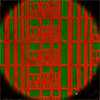| Dec 05, 2022 |
|
(Nanowerk News) Hyperspectral surface plasmon resonance microscopy (HSPRM) is an advanced analytical technique for spectral imaging and chemical and biological sensing, which enables high-resolution visualization and precise quantification of chemical and biological analytes.
|
|
A study published in Nature Communications (“Flexible hyperspectral surface plasmon resonance microscopy”) describes a flexible HSPRM system that operates by using a hyperspectral microscope to analyze the selected area of SPR image produced by a prism-based spectral SPR sensor.
|
|
The HSPRM system is developed by a research team from the Aerospace Information Research Institute (AIR) of the Chinese Academy of Sciences (CAS).
|
|
The HSPRM system enables monochromatic and polychromatic SPR imaging and single-pixel spectral SPR sensing, as well as two-dimensional quantification of thin films with measured resonance-wavelength images. It can measure SPR radiance spectra instead of conventional intensity spectra to improve the figure of merit (FOM) of single-pixel spectral SPR sensors and can also quantify two-dimensional profiles of thickness and refractive index for thin films by using measured resonance-wavelength images.
|
|
Pixel-by-pixel calibration of the incident beam collimation deviation was performed to remove pixel-to-pixel differences in SPR sensitivity.
|
|
The HSPRM system has a wide spectral range from 400 nm to 1,000 nm, an optional field of view from 0.884 mm2 to 0.003 mm2 and a high lateral resolution of 1.2 µm.
|
|
Typical applications of the HSPRM system include quantification of single-layer graphene thickness distribution, in situ detection of inhomogeneous protein adsorption, and label-free single cell analysis.
|

